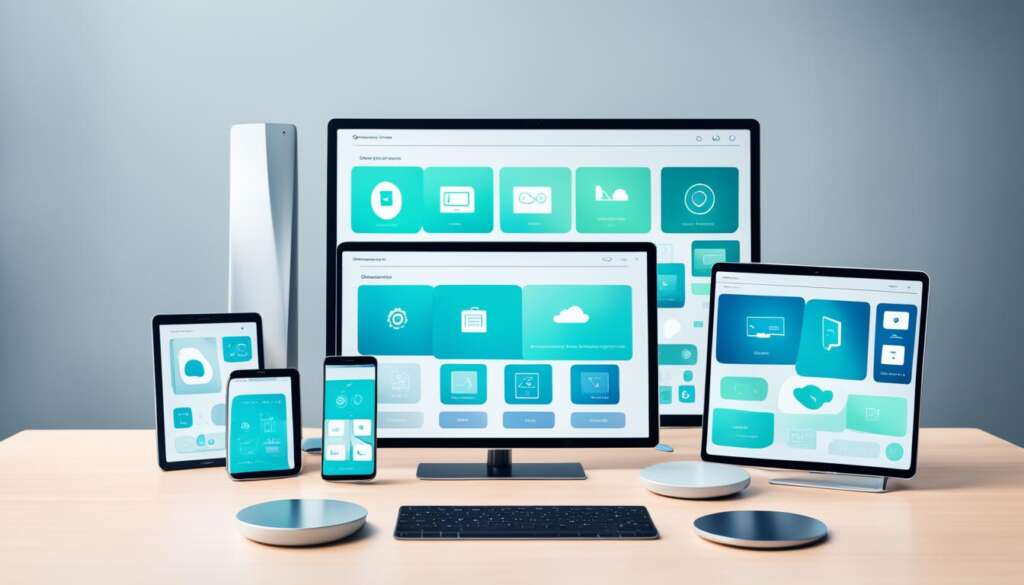Table of Contents
Americans spend an average of 5 hours on mobile devices every day. Our reliance on technology is limiting our ability to imagine possibilities beyond a screen. The shift to screenless experiences is underway with the rise of the Internet of Things, virtual reality, and improved AI. This shift is both technological and societal, providing an opportunity to make our lives more joyful, human, present, and productive.
Introducing responsive smart devices, a new era where technology adapts to us. Responsive design is at the forefront of this revolution, ensuring that our devices seamlessly adjust to our needs and preferences. Whether it’s a smartphone, smartwatch, or smart speaker, these devices are becoming an extension of ourselves, providing personalized experiences like never before.
Responsive design goes beyond just making websites and applications look good on different screen sizes. It focuses on creating an optimal user experience across all devices, ensuring that functionality, usability, and performance are top-notch. By incorporating responsive design principles, businesses can stay ahead of the curve by delivering exceptional experiences to their users.
In this article, we will explore the benefits of responsive design and how it can elevate the way we interact with smart devices. From the invisible interface to the integration of screens with other interfaces, we will delve into the possibilities unlocked by responsive design. We will also discuss adaptive design, a user-centric approach that tailors the user experience to different devices and contexts.
Join us on this journey as we look beyond screens and embrace the future of technology, where our devices adapt to us and enhance our lives in ways we never thought possible.
The Invisible Interface is More In-the-Moment, Human and Joyful
Screens often detach us from our environment, while invisible interfaces can bring us closer to it. By removing friction and distractions, invisible interfaces allow us to be more present and engage with the world in a more meaningful way. They have the potential to foster human connection, create joy, and enhance our overall well-being. Face-to-face human interaction is essential for true belonging, and technology can facilitate this through social media and other means.
“Invisible interfaces have the power to dissolve the barriers between technology and human interaction, providing us with a more seamless and immersive experience.”
— Jane Thompson, Interaction Design Expert
With invisible interfaces, we can break free from the confines of a screen and interact with the world around us in real-time. Whether it’s through voice commands, gesture recognition, or intuitive sensors, these interfaces enable us to engage in in-the-moment interactions with the technology that surrounds us.
Imagine walking into a smart home and seamlessly adjusting the lighting, temperature, and music by simply speaking commands or making subtle gestures. This type of interaction eliminates the need for physical touchpoints or complex navigation, creating a more natural and intuitive experience.
Moreover, invisible interfaces have the potential to enhance our daily routines and bring more joy into our lives. From smartwatches that track our fitness goals with precision to augmented reality apps that add a layer of fun and excitement to our surroundings, these interfaces can transform mundane tasks into joyful experiences.
Enhancing Human Connection
One of the most remarkable aspects of invisible interfaces is their ability to foster human connection. By seamlessly integrating technology into our social interactions, invisible interfaces enable us to stay connected with our loved ones, even when physically apart.
Take social media platforms as an example. While they may have their fair share of drawbacks, they also provide us with a unique opportunity to connect with people from all corners of the globe. Through invisible interfaces, we can share our thoughts, experiences, and emotions with a simple tap or swipe, creating a sense of belonging in the digital space.
“Invisible interfaces have the potential to bridge the gap between the physical and digital worlds, enabling us to establish genuine connections with others regardless of distance.”
— Mark Adams, Social Media Strategist
Additionally, invisible interfaces can facilitate more meaningful interactions in face-to-face settings. Imagine attending a conference or networking event where participants can instantly exchange contact information by simply tapping their smartphones together. This frictionless interaction not only saves time but also facilitates the growth of personal and professional relationships.
Celebrating the Joyful Experience
Invisible interfaces have the remarkable ability to elevate the joy in our everyday experiences. Whether it’s capturing a breathtaking sunset with our smartphones, playing an immersive virtual reality game, or using a voice-activated smart assistant to curate a personalized music playlist, these interfaces enhance our ability to find joy in the moment.
The seamless integration of technology into our lives through invisible interfaces allows us to immerse ourselves in experiences that were previously inaccessible. These interfaces empower us to explore new realms, learn new skills, and engage in activities that bring us pure joy and fulfillment.
Screens Should Work in Concert with Other Interfaces
Rather than relying solely on screens, it is essential to design interfaces that work in harmony with other devices and technologies. This integrated approach allows us to leverage the strengths of each interface for specific tasks, resulting in a more seamless and efficient user experience.
For example, imagine wearing a discreet wearable device that can record notes during a meeting. This hands-free interface allows users to capture important information without the need to focus on a screen. Later, a smartphone can be used to review and edit the recorded notes, taking advantage of its larger screen and more robust editing capabilities.
“Combining different interfaces enables us to create a user experience that is tailored to specific tasks, maximizing productivity and convenience.”
This concerted interaction between screens and other interfaces opens up new possibilities for enhancing user experiences. By considering the strengths and limitations of different devices, we can design interfaces that complement one another, resulting in more efficient and effective interactions.
Benefits of Using Multiple Interfaces:
- Improved productivity by utilizing the strengths of each interface.
- Enhanced user engagement through a varied and tailored user experience.
- Efficient and seamless task completion by allocating tasks to the most suitable interfaces.
- Flexibility in interaction modes, accommodating diverse user preferences and situations.
This holistic approach to interface design fosters a more versatile and user-centric experience. By combining screens with other interfaces, we can create a truly optimized user experience that exceeds the limitations of traditional screen-based interactions.
Next, we will explore how thinking beyond screens opens up new possibilities and ignites our imaginations to solve problems in innovative ways.
We Can Stretch Our Imaginations Beyond Screens
While screens are still useful for certain tasks, spending excessive time on them is not always the most efficient or human-centric way to interact with the world. With advancements in AI, VR, and IoT, we have the opportunity to explore new ways of solving problems and engaging with technology. By thinking beyond screens, we can create solutions that are more intuitive, natural, and tailored to human needs and preferences.
Imaginations can soar when we break free from the confines of traditional screens. Instead of being limited by the two-dimensional interface of a smartphone or a computer monitor, we can tap into a world of limitless possibilities. VR technology, for example, allows us to step into immersive virtual environments and interact with them in ways that were previously unimaginable.
The use of VR goes beyond gaming and entertainment. Industries such as healthcare, architecture, and education are incorporating VR to revolutionize their practices. Surgeons can practice complex procedures in a realistic virtual environment, architects can walk clients through virtual buildings before they are constructed, and students can have interactive learning experiences that bring subjects to life.
The IoT is another avenue through which we can expand our imaginations beyond screens. With smart devices seamlessly integrated into our homes and workplaces, we can control our environments in ways that were once only part of science fiction. From adjusting the lighting and temperature with a voice command to having our coffee ready the moment we wake up, the IoT presents new possibilities for convenient and efficient living.
Problem solving also benefits from thinking beyond screens. AI-powered virtual assistants, such as Alexa and Siri, can understand and respond to natural language, making it easier to find information and accomplish tasks. These virtual assistants can help with everything from setting reminders and making appointments to providing recommendations based on our preferences.
In conclusion, it is essential to tap into our imaginations and explore the possibilities beyond screens. Advancements in technology like AI, VR, and the IoT provide us with new tools and experiences that can enhance problem-solving and interaction. By embracing these technologies, we can create intuitive, natural, and tailored solutions that improve our lives in ways we never thought possible.
Benefits of Thinking Beyond Screens
- Enhanced creativity and innovation
- Improved problem-solving capabilities
- More immersive and engaging experiences
- Increased convenience and efficiency
- Tailored solutions that meet individual needs
Comparing Screen-Centric and Beyond-Screen Experiences
| Screen-Centric | Beyond-Screen | |
|---|---|---|
| Interaction | Limited to touch and mouse input | Multi-sensory and interactive |
| Engagement | Can be detached and distracting | Immersive and focused |
| Creativity | Restricted by screen size and format | Unbounded and limitless |
| Efficiency | Can be time-consuming and inefficient | Streamlined and optimized |
| Personalization | Generic and one-size-fits-all | Customized and tailored |
Thinking beyond screens opens up a world of new possibilities and experiences. It challenges us to reimagine the way we interact with technology and offers solutions that are more intuitive, immersive, and tailored to our needs. By embracing this shift, we can unlock our imaginations and solve problems in innovative ways.
Adaptive Design: Tailoring the User Experience
Adaptive design is a user-centric approach that goes beyond responsive design. It takes into consideration various devices, contexts, and user preferences to create a tailored user experience. By considering factors such as screen size, device capabilities, and user needs, adaptive design ensures that websites and applications function flawlessly across all platforms. It enhances user satisfaction, improves accessibility, and future-proofs the design for emerging technologies.
Adaptive design considers the diversity of devices used by users today, including smartphones, tablets, laptops, and smart TVs. It recognizes the different capabilities and constraints of each device and optimizes the user interface accordingly. For example, adaptive design may adjust the layout and font size to accommodate smaller screens while providing a consistent and engaging experience. This adaptability ensures that users can access and interact with content seamlessly, regardless of the device they use.
One of the key advantages of adaptive design is its ability to enhance user experience by tailoring the interface to individual preferences. By considering user preferences such as font size, color scheme, and interaction patterns, adaptive design creates a personalized experience that aligns with users’ needs and enhances their satisfaction. This user-centric approach fosters engagement and strengthens the connection between the user and the interface.
Moreover, adaptive design improves the accessibility of websites and applications for users with disabilities or impairments. By incorporating features such as text-to-speech, high-contrast modes, and keyboard navigation options, adaptive design ensures that all users can access and interact with digital content effectively. This inclusivity contributes to a positive user experience and demonstrates a commitment to equal access for all.
Achieving Device Compatibility with Adaptive Design
Device compatibility is a crucial aspect of adaptive design. It involves designing and developing websites and applications that are compatible with a wide range of devices, operating systems, and browsers. This compatibility ensures that users can access and use digital content regardless of their chosen device or platform.
Adaptive design employs techniques such as responsive web design, device detection, and server-side rendering to achieve device compatibility. Responsive web design allows the content to adapt to different screen sizes and resolutions, ensuring a consistent experience across devices. Device detection detects the user’s device and tailors the content accordingly, optimizing performance and user experience. Server-side rendering enables the server to generate content that is specific to the requesting device, further enhancing device compatibility.
By implementing adaptive design principles, businesses can future-proof their designs and ensure compatibility with emerging technologies. As new devices and platforms continue to emerge, adaptive design allows for seamless adaptation, enabling users to access and interact with content using the latest technologies. This adaptability fosters innovation and ensures that businesses can meet the evolving needs and expectations of their users.
“Adaptive design enhances user satisfaction, improves accessibility, and future-proofs the design for emerging technologies.”
| Benefits of Adaptive Design | User Satisfaction | Performance | Future-proofing |
|---|---|---|---|
| Enhances the user experience by tailoring the interface to individual preferences | Improves loading times and overall performance for better user engagement | Ensures compatibility with emerging technologies and future device innovations | |
| Promotes inclusivity by catering to users with disabilities or impairments | Reduces bounce rates and increases user retention | Adapts content to new screen sizes, resolutions, and interaction patterns | |
| Creates a consistent and engaging experience across devices | Optimizes accessibility features, such as text-to-speech and high-contrast modes | Fosters innovation and allows for easy adaptation to new technologies |
The Benefits of Adaptive Design
Adaptive design offers several benefits for businesses and users. By implementing adaptive design principles, businesses can create a seamless and exceptional user experience that improves user satisfaction and engagement.
Catering to User Needs and Preferences
Adaptive design enables websites and applications to tailor the user experience to their specific needs and preferences. By considering factors such as screen size, device capabilities, and user requirements, adaptive design ensures that users have a customized and personalized interaction with the digital platform. This level of customization enhances user satisfaction and overall engagement.
Enhanced Website Performance
Adaptive design also improves website performance by optimizing it for different devices and platforms. By adapting the design based on the user’s device, adaptive design reduces load times and bounce rates, resulting in a faster and more efficient user experience. This improvement in performance translates to higher user satisfaction and increased conversion rates.
Future-Proofing the Design
One of the key advantages of adaptive design is its ability to future-proof the design. With the rapid advancements in technology and the continuous emergence of new devices and platforms, adaptive design ensures that websites and applications remain compatible and functional across various platforms. This adaptability allows businesses to easily incorporate new technologies and devices into their design without having to undergo significant redesign efforts.
| Benefits of Adaptive Design | Description |
|---|---|
| User Satisfaction | Customized user experience based on individual needs and preferences enhances satisfaction and engagement. |
| Performance | Optimized for different devices, resulting in faster load times and reduced bounce rates. |
| Future-Proofing | Easily adaptable to new devices and technologies, ensuring longevity and compatibility. |
By leveraging the benefits of adaptive design, businesses can create a user-centric experience that drives customer satisfaction, improves performance, and future-proofs their digital assets.
Implementing Adaptive Design
Implementing adaptive design effectively requires the expertise of a knowledgeable and experienced web design agency. By partnering with a reputable agency, businesses can ensure that their websites provide a seamless and tailored user experience across different devices and screen sizes.
The first step in implementing adaptive design is conducting thorough research to understand the target audience and their unique needs. This research forms the foundation for creating a design strategy that addresses user preferences and expectations.
Responsive design techniques play a crucial role in adaptive design. These techniques allow websites to adapt to various screen sizes and resolutions. By using flexible layouts, fluid grids, and media queries, web designers can ensure that the website’s content and visual elements adjust dynamically to different devices.
User testing is another essential aspect of implementing adaptive design. By gathering feedback from actual users, businesses can identify areas for improvement and make necessary adjustments to enhance the user experience. User testing helps ensure that the website performs optimally and meets evolving user expectations.
“Implementing adaptive design is a continuous process of improvement. By collecting and analyzing user feedback, businesses can make data-driven decisions to enhance the adaptive user experience. Continuous improvement allows for the identification of potential issues and the implementation of innovative solutions, ultimately leading to a seamless and exceptional user experience.”
As technology and user preferences evolve, it is crucial to continuously iterate and improve the adaptive design. By embracing a mindset of continuous improvement, businesses can stay ahead of the curve and provide a user experience that is always optimized for the latest trends and technologies.
Benefits of Implementing Adaptive Design
Implementing adaptive design offers numerous benefits for businesses and users alike. Here are some key advantages:
- Enhanced User Satisfaction: Adaptive design ensures that users can easily navigate and interact with the website across different devices, leading to higher satisfaction levels.
- Improved Performance: Websites that implement adaptive design load faster and have lower bounce rates, providing a smooth and efficient user experience.
- User-Friendly Interface: Adaptive design creates a user-friendly interface that adapts to individual user preferences, making it easier for users to find the information they need.
- Future-Proof Design: By considering various devices and technologies, adaptive design future-proofs websites, allowing for easy adaptation to emerging technologies.
By implementing adaptive design principles, businesses can create a user experience that is not only visually appealing but also functional and accessible across a wide range of devices.
| Benefits of Adaptive Design | Description |
|---|---|
| Enhanced User Satisfaction | Adaptive design ensures a seamless user experience, resulting in higher user satisfaction levels. |
| Improved Performance | Websites with adaptive design have faster loading times and lower bounce rates, improving overall performance. |
| User-Friendly Interface | Adaptive design creates a user-friendly interface that adapts to individual user preferences, making it easier to navigate. |
| Future-Proof Design | By considering various devices and technologies, adaptive design allows for easy adaptation to emerging technologies. |
Implementing adaptive design is essential to stay ahead in the ever-changing digital landscape. By working with a web design agency, conducting user testing, and embracing continuous improvement, businesses can create a tailored and future-proof user experience that meets the evolving needs of their audience.
Conclusion
In conclusion, adaptive design plays a crucial role in the age of smart devices. It surpasses the limitations of responsive design by creating a tailored user experience that adapts seamlessly to different devices, contexts, and user preferences. Incorporating adaptive design principles enables businesses to elevate user satisfaction, optimize performance, and future-proof their designs.
By embracing adaptive design, businesses can deliver a remarkable user experience that resonates with their target audience. Tailoring the design to meet user needs and preferences enhances engagement and builds brand loyalty. Additionally, adaptive design ensures that websites and applications function flawlessly across various platforms, regardless of screen size or device capabilities.
As technology continues to evolve, it’s essential to stay ahead of the curve. Adaptive design provides a forward-thinking approach to web design, enabling businesses to adapt effortlessly to emerging technologies and devices. By focusing on creating a seamless and exceptional user experience, businesses can establish a competitive edge, fostering long-term success in the era of responsive smart devices.
FAQ
What is responsive design?
Responsive design is an approach to web design that ensures websites and applications function flawlessly across all platforms. It takes into consideration factors such as screen size, device capabilities, and user needs to create a tailored user experience.
How does adaptive design differ from responsive design?
Adaptive design goes beyond responsive design by considering various devices, contexts, and user preferences. It takes a user-centric approach and ensures that websites and applications adapt seamlessly to different screen sizes and resolutions.
What are the benefits of adaptive design?
Adaptive design offers several benefits, including improved user satisfaction and engagement, enhanced website performance, and future-proofing of the design for emerging technologies.
How can businesses implement adaptive design effectively?
To implement adaptive design effectively, it is crucial to work with a knowledgeable and experienced web design agency. They will conduct thorough research, utilize responsive design techniques and user testing, and continuously improve the user experience based on feedback.
Why is responsive design important in the age of smart devices?
Responsive design is important in the age of smart devices to ensure that websites and applications adapt to different devices and provide a seamless user experience. It allows businesses to meet the evolving expectations of users and future-proof their designs.













